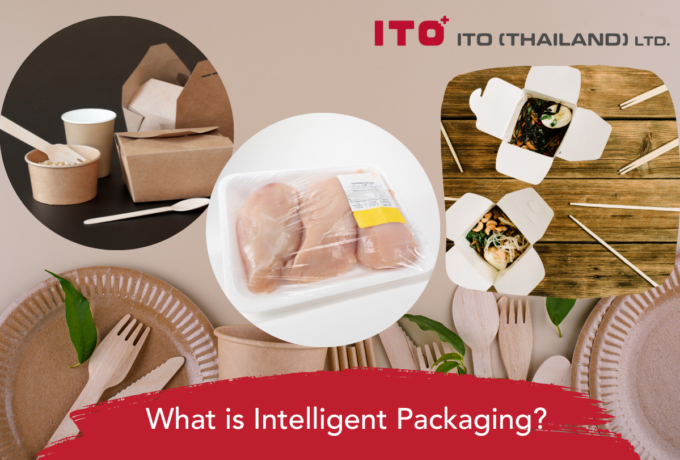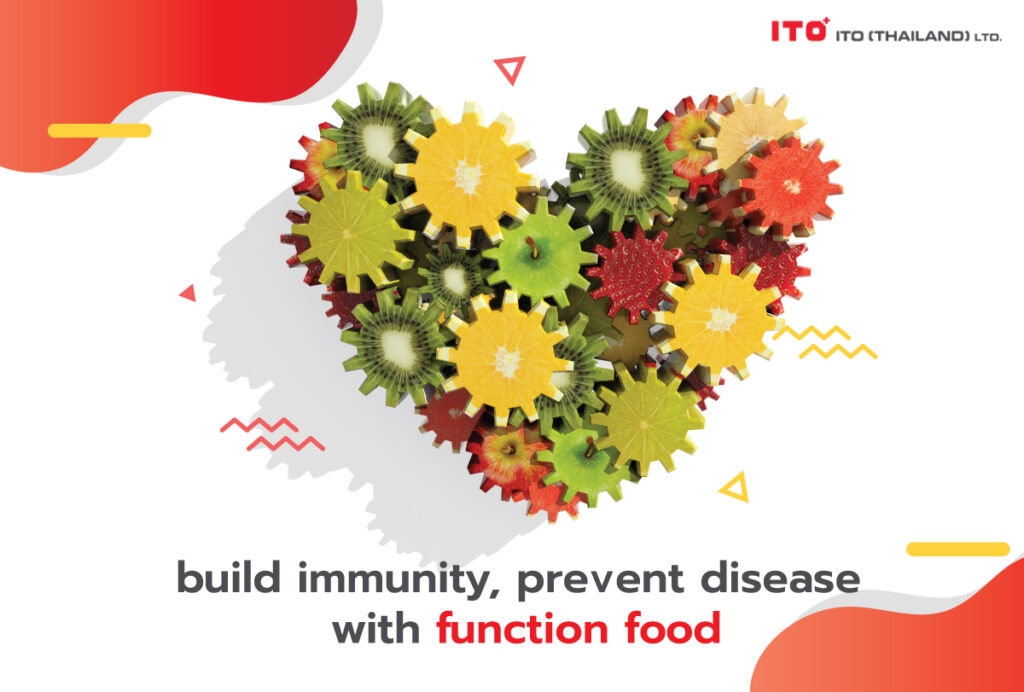ITO Thailand Hygiene Blog
Functional Foods
At present, consumers are more in need of foods that promote health, coupled with the aging society, resulting in more need for promotion of good health: reducing the risk or treatment of diseases that have just begun to prevent them from spreading further. This is where functional foods meet such needs, which will highlight the products of entrepreneurs to differentiate from other products in the market, with added values, allowing them to compete in the market. It is an interesting alternative for entrepreneurs
Functional foods have a wide range of sources depending on the interests of consumers. For general consumers, they are often interested in foods that have functions for various bodily functions such as: making your body function better, reducing the risk of disease, or relieving symptoms of the disease.
For the gastrointestinal tract, distinctive functional foods are dietary fibers, probiotics, and prebiotics. Dietary fibers are carbohydrates that are indigestible by the body. They help with the gastrointestinal tract and excretion and can be divided into two groups: soluble and insoluble. The soluble group can absorb water in the structure and has characteristics of gel or soft mucus, such as pectin, gum, and some hemicellulose. It helps to disrupt and slow down the sugar entering the veins and reduces the absorption of cholesterol in food into the body.
Insoluble fiber, such as cellulose, hemicellulose, and lignin, increases fecal mass, improves excretion, and causes the movement of the gastrointestinal tract and intestine [1]. Probiotics are living microorganisms and are good microorganisms for the body: they can produce nutrients, vitamins, enzymes that aid digestion that the digestive juices in the body cannot digest, they reduce flatulence, balance the intestines, reduce the number of bad microorganisms in the intestines [2]. Probiotics may be in the form of supplements in tablets or drinking powders, or in foods that contain fermentation processes and are packaged without disinfecting microorganisms such as fermented milk, yogurt, kimchi, fermented beans, miso, etc.
Prebiotics are short-chain carbohydrates that the human body cannot digest. They are part of the dietary fiber, but they are special: they can be digested with probiotics in the colon, so they are food for microorganisms, allowing good microorganisms to grow and a precursor to the synthesis of substances that are beneficial to the body. The criteria for classifying prebiotics are
1. Resistance to the digestion of acids and enzymes in the gastrointestinal tract of mammals.
2. They can be fermented by microorganisms in the gastrointestinal tract well.
3. They encourage good microorganisms to grow and/or create beneficial substances [3]. Examples of prebiotics include galactooligosaccharides, fructooligosaccharides, and inulin.
The cardiovascular system is another function that has attracted a lot of attention because it is one of the leading causes of death today. Foods with this function include fiber, phytosterol (a cholesterol-like substance found in plants), oleic acids, unsaturated fatty acids, antioxidants, phytochemicals, and bioactive peptides [4]. These substances have different mechanisms of action, including reducing cholesterol in the blood, inhibiting bad cholesterol oxidation, reducing triglycerides, reducing blood pressure, promoting functions of cells lining blood vessel walls, and promoting platelet adherence, which helps to fill blood vessel tears [5].
In addition to nourishment, there are also functional foods for specific needs, also known as tailor-made foods, such as low glycemic indexes for people with diabetes and obesity, improving the portion of carbohydrates to make enzymes in the body more difficult to digest. Therefore, it satiates for a long time and reduces blood sugar fluctuations [Read more at Alternative Carbohydrates]
As for those who control the weight, in addition to being satiated for a long time, fiber or additional metabolic aids may be added. Food for patients with chronic kidney disease must have controlled protein and salt intake. The food must also be high in energy because patients often eat limited foods. The same goes for food for the elderly. In addition to adequate energy and nutrients, because their intake is also limited, it is also necessary to consider the texture that is not too hard or viscous. They must be able to chew and swallow without choking. For athletes, they need high energy because they use a lot of energy and require protein to strengthen the muscles. So, a high-protein diet or new source of protein has been developed to meet the needs of this group of consumers. [Read more at Alternative Proteins]
References:
1. https://www.webmd.com/diet/features/insoluble-soluble-fiber
2.Soccol, C. R., Vandenberghe, L. P. D. S., Spier, M. R., Medeiros, A. B. P., Yamaguishi, C. T., Lindner, J. D. D., … & Thomaz-Soccol, V. (2010). The potential of probiotics: a review. Food Technology and Biotechnology, 48(4), 413-434.
3.Al-Sheraji, S. H., Ismail, A., Manap, M. Y., Mustafa, S., Yusof, R. M., & Hassan, F. A. (2013). Prebiotics as functional foods: A review. Journal of functional foods, 5(4), 1542-1553.
4.Koutelidakis, A., & Dimou, C. (2016). The effects of functional food and bioactive compounds on biomarkers of cardiovascular diseases. Functional Foods Text Book, 1st ed.; Martirosyan, D., Ed, 89-117.
5.Asgary, S., Rastqar, A., & Keshvari, M. (2018). Functional food and cardiovascular disease prevention and treatment: a review. Journal of the American College of Nutrition, 37(5), 429-455.
Related Post
-

Biodegradable Packaging
As straightforward as its name, it means any packaging that will naturally fall apart and decompose. In recent years, biodegradable packaging has been included as one of the sustainable development goals for several organisations. A similar issue, bioplastics, an alternative to sustainable living, was discussed in a previous blog. However, there are some differences between them. For example, bioplastics are made from raw materials sourced from renewable and natural sources and could or could not be biodegradable. In contrast, biodegradable plastic can naturally degrade through living organisms no matter the source material it originates from. The development history of biodegradable packaging, frequently used materials, the pros and cons of biodegradable packaging, and its future trends will be discussed in this blog.
-

Precision Agriculture
Precision agriculture has revolutionised how we approach crop management by optimising the inputs to meet specific requirements. Even though it is not a new system, recent technologies have made it possible to apply it in practical productions. In this blog, we will discuss the definition of precision agriculture, its pros and cons, and future trends.
-

Vertical Farming
Agriculture has utilised nearly all the available land, causing growing difficulty in finding land on the earth’s surface. With limited resources, meeting the world’s food demands will require more innovative and dependable methods of producing safe food, and the answer lies in vertical farming.
-

Intelligent Packaging
Without packaging, food products would last for only a short period of time, impossible for logistics management, difficulties in the supply chain system, quick quality deterioration, and prone to contamination to risky foodborne pathogens. In reality, there are many more functions that packaging is contributing to food products, as well as many types of smart packaging. Intelligent packaging is considered to be a part of smart packaging, so in this blog, we will discuss the contribution of intelligent packaging to food products.
-

Robots & automation in the food industry
Entering a new era in the food industry with robotics and automation in the food industry
-

Nanotechnology in the Food Industry
Nanotechnology has been brought to our attention for the last decades, and it has provided various beneficial applications to the food industry. Unlike other technology, nanotechnology has broadened the knowledge in the food industry to another level in a nanoscale dimension. It involves almost every aspect of the food industry, including food packaging, food processing, as well as functional food development and enhancement of food safety. In this blog, we will discuss how nanotechnology is used in food packaging and food products, and the most important part, its safety issues.










